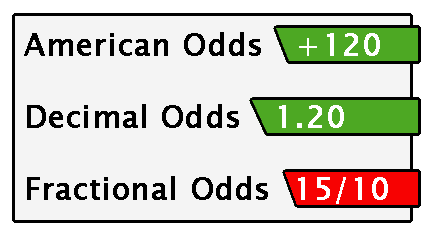 You’ve probably seen a headline before that looks something like this: “Golden State Warriors now at +700 to win the NBA Championship” or maybe something like: “New England Patriots open as the favorite to win the Super Bowl next year with 7/1 odds” or perhaps even “Conor McGregor gets 8.00 odds for next fighting bout.”
You’ve probably seen a headline before that looks something like this: “Golden State Warriors now at +700 to win the NBA Championship” or maybe something like: “New England Patriots open as the favorite to win the Super Bowl next year with 7/1 odds” or perhaps even “Conor McGregor gets 8.00 odds for next fighting bout.”
These examples are purely hypothetical of course, but what does all this mean? Well simply put: all three examples mean the exact same thing and, in this example, are even the exact same betting odds, but they are just shown differently. There are three types of odds when it comes to futures betting: American odds, Fractional odds, and Decimal odds.
American Odds Explained

We’ll start with the Warriors +700 example. In the United States, this will typically be your most common odds given by a sportsbook. +700 means you bet $100 and you will profit $700, getting back a total of $800. Pretty simple, right? But what if you don’t want to bet $100 and only $10 instead? Easy: you will win $70 and get back a total of $80. The American odds essentially use $100 as a baseline when displaying +(Insert Amount).
But what if you see this: -700. Don’t panic when seeing a negative number, but it does work a bit differently than a +700. So as stated above, if the odds are +700 then that means you need to wager $100 to win $700, however it works in reverse if the odds are negative. Having -700 odds means you must bet $700 to win $100.
Doesn’t sound like a good invest right? Well it could be because negative American odds will only show up when something is extremely likely to happen, thus making your potential earnings a lot less because there is less risk involved when betting on a heavy favorite.
Fractional Odds Explained
These kinds of odds are probably the easiest and universally well-known odds in not only futures betting but all of gambling in general. Take the Patriots hypothetical 7/1 odds. The first number, in this case the 7, of the fraction represents the amount you will win if you wager the second number, which is the 1. So, for every $1 wagered, you would win $7. $2 for $14, $10 for 70$, $100 for $700 and so on.
Basically, the first or top number is always the amount you’ll win and the second or bottom number is the amount you must wager. Combine the top and the bottom and that’s your total amount. So even if the odds are something like 3/5, just know in this example that to win $3 you’d have to wager $5.
Decimal Odds Explained
You aren’t likely to see decimal odds in too many places, but in case you do, you’ll know exactly what they mean after reading this section. Take Conor McGregor’s 8.00 odds to win from the above example. 8.00 represents the total amount you will win from a $1.00 wager and has the amount you wagered already included in the betting line.
Don’t mistake 8.00 to be 8/1 because it is actually 7/1. 8.00 is the sum of fractional odds, so to get 8.00 you would just take 7/1 and do 7+1=8. If you wanted to see the total amount you’d win if you, say, placed a $100 wager on 8.00 then you simply multiply times the amount you to wager, so it’d be 8.00x$100=$800.00.
If the odds are something like 1.50 as an example, then you now know for every $1 bet on this line, you will get a total of $1.50 back, which means only $0.50 of profit. Just know betting $1 on the decimal number will give you the exact amount of the decimal number and multiply by how much you’re willing to wager.
Payouts of Futures
Once a futures bet is placed, the payout will not be awarded until after the sports contest or event has ended. This could mean the payout for a futures wager might not occur for several weeks or months after being initially placed.
Because future bets are placed ahead of time, the value most of the time is at its highest when the sports contest or event is furthest away due to more uncertainty of the outcome. As the day of the outcome draws near, a once uncertain future becomes more clear, and while the odds of you winning the futures bet will likely get better, the payout from the futures bet will become worse.
